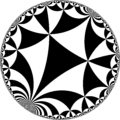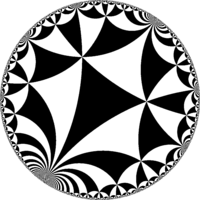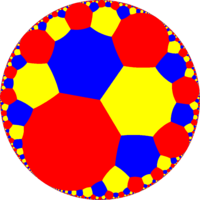| Infinite-order truncated square tiling | |
|---|---|
 Poincaré disk model of the hyperbolic plane | |
| Type | Hyperbolic uniform tiling |
| Vertex configuration | ∞.8.8 |
| Schläfli symbol | t{4,∞} |
| Wythoff symbol | 2 ∞ | 4 |
| Coxeter diagram | |
| Symmetry group | [∞,4], (*∞42) |
| Dual | apeirokis apeirogonal tiling |
| Properties | Vertex-transitive |
In geometry, the truncated infinite-order square tiling is a uniform tiling of the hyperbolic plane. It has Schläfli symbol of t{4,∞}.
YouTube Encyclopedic
-
1/5Views:12 3241 02988437356 917
-
Mod-01 Lec-06 Geometry of Crystals: Symmetry, Lattices
-
8. Quasi-Newton-Raphson Methods
-
Atlantean Daily Life (1/14): Housing (a lecture by: Jonathan Barlow Gee)
-
Rethinking Pei: A Centenary Symposium, Panel 3: Power, Capital, and People
-
Lec-1 Structure of Materials Part-I
Transcription
Uniform color
In (*∞44) symmetry this tiling has 3 colors. Bisecting the isosceles triangle domains can double the symmetry to *∞42 symmetry.
Symmetry
The dual of the tiling represents the fundamental domains of (*∞44) orbifold symmetry. From [(∞,4,4)] (*∞44) symmetry, there are 15 small index subgroup (11 unique) by mirror removal and alternation operators. Mirrors can be removed if its branch orders are all even, and cuts neighboring branch orders in half. Removing two mirrors leaves a half-order gyration point where the removed mirrors met. In these images fundamental domains are alternately colored black and white, and mirrors exist on the boundaries between colors. The symmetry can be doubled to *∞42 by adding a bisecting mirror across the fundamental domains. The subgroup index-8 group, [(1+,∞,1+,4,1+,4)] (∞22∞22) is the commutator subgroup of [(∞,4,4)].
| Fundamental domains |

|
 
|
 
|
 
|
 
|

|
|---|---|---|---|---|---|---|
| Subgroup index | 1 | 2 | 4 | |||
| Coxeter (orbifold) |
[(4,4,∞)] (*∞44) |
[(1+,4,4,∞)] (*∞424) |
[(4,4,1+,∞)] (*∞424) |
[(4,1+,4,∞)] (*∞2∞2) |
[(4,1+,4,1+,∞)] 2*∞2∞2 |
[(1+,4,4,1+,∞)] (∞*2222) |
| [(4,4+,∞)] (4*∞2) |
[(4+,4,∞)] (4*∞2) |
[(4,4,∞+)] (∞*22) |
[(1+,4,1+,4,∞)] 2*∞2∞2 |
[(4+,4+,∞)] (∞22×) | ||
| Rotational subgroups | ||||||
| Subgroup index | 2 | 4 | 8 | |||
| Coxeter (orbifold) |
[(4,4,∞)]+ (∞44) |
[(1+,4,4+,∞)] (∞323) |
[(4+,4,1+,∞)] (∞424) |
[(4,1+,4,∞+)] (∞434) |
[(1+,4,1+,4,1+,∞)] = [(4+,4+,∞+)] (∞22∞22) | |
Related polyhedra and tiling
| *n42 symmetry mutation of truncated tilings: n.8.8 | |||||||||||
|---|---|---|---|---|---|---|---|---|---|---|---|
| Symmetry *n42 [n,4] |
Spherical | Euclidean | Compact hyperbolic | Paracompact | |||||||
| *242 [2,4] |
*342 [3,4] |
*442 [4,4] |
*542 [5,4] |
*642 [6,4] |
*742 [7,4] |
*842 [8,4]... |
*∞42 [∞,4] | ||||
| Truncated figures |

|

|

|

|

|

|

|

| |||
| Config. | 2.8.8 | 3.8.8 | 4.8.8 | 5.8.8 | 6.8.8 | 7.8.8 | 8.8.8 | ∞.8.8 | |||
| n-kis figures |

|

|

|

|

|

|

|

| |||
| Config. | V2.8.8 | V3.8.8 | V4.8.8 | V5.8.8 | V6.8.8 | V7.8.8 | V8.8.8 | V∞.8.8 | |||
| Paracompact uniform tilings in [∞,4] family | |||||||
|---|---|---|---|---|---|---|---|

|

|

|

|

|

|

| |
| {∞,4} | t{∞,4} | r{∞,4} | 2t{∞,4}=t{4,∞} | 2r{∞,4}={4,∞} | rr{∞,4} | tr{∞,4} | |
| Dual figures | |||||||

|

|

|

|

|

|

| |
| V∞4 | V4.∞.∞ | V(4.∞)2 | V8.8.∞ | V4∞ | V43.∞ | V4.8.∞ | |
| Alternations | |||||||
| [1+,∞,4] (*44∞) |
[∞+,4] (∞*2) |
[∞,1+,4] (*2∞2∞) |
[∞,4+] (4*∞) |
[∞,4,1+] (*∞∞2) |
[(∞,4,2+)] (2*2∞) |
[∞,4]+ (∞42) | |
= |
= |
||||||
| h{∞,4} | s{∞,4} | hr{∞,4} | s{4,∞} | h{4,∞} | hrr{∞,4} | s{∞,4} | |

|

|

|

| ||||
| Alternation duals | |||||||

|

|
||||||
| V(∞.4)4 | V3.(3.∞)2 | V(4.∞.4)2 | V3.∞.(3.4)2 | V∞∞ | V∞.44 | V3.3.4.3.∞ | |
See also
References
- John H. Conway, Heidi Burgiel, Chaim Goodman-Strauss, The Symmetries of Things 2008, ISBN 978-1-56881-220-5 (Chapter 19, The Hyperbolic Archimedean Tessellations)
- "Chapter 10: Regular honeycombs in hyperbolic space". The Beauty of Geometry: Twelve Essays. Dover Publications. 1999. ISBN 0-486-40919-8. LCCN 99035678.
External links
- Weisstein, Eric W. "Hyperbolic tiling". MathWorld.
- Weisstein, Eric W. "Poincaré hyperbolic disk". MathWorld.
- Hyperbolic and Spherical Tiling Gallery




